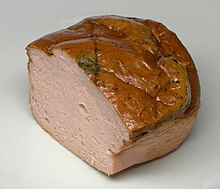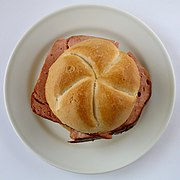Meat loaf
As meat loaf , meat (also -kas ) or meat loaf is the name given to a type of boiled sausage . Its square pie shape is characteristic. Liver is usually not used in the production. The name cheese is only derived from the shape of the loaves.
etymology
Leberkäse originally means “leftovers in the box”, which aptly describes how the product is made. The name Leberkäse is sometimes misleading, as Leberkäse originally had no relation to the liver , as is still the case today in Bavarian Leberkäs. The term is made up of the nouns liver and cheese . Liver is originally derived from Old High German laiba , which means something like rest; analogously, the term is also used in place names such as B. in Oschersleben or Eisleben ; a direct derivation of “laif” for body comes from the same word context. The suffix -käse is a dialect variant for box (see also English: "case").
In Austria, both the terms are meat loaf and meat loaf consistently; however, both are used regionally and locally with different frequency. Leberkäse is common in most parts of the country, meat loaf only in the western federal states.
preparation
A sausage meat is generally used for meat loaf , which is also used for meat sausage . It consists of lean, low-tendon pork , bacon and finely grated ice cream . Sometimes beef is also added. The ingredients are finely chopped and seasoned. Typical spices and condiments are curing salt , pepper , mace , coriander and ginger . In commercial sausage production, glutamate and color stabilizers are also used, as the curing salt is intended to achieve and maintain reddening. The mixture is then filled into special meat loaf molds or box-shaped roasting pans and cooked or baked in the oven . This preparation is considered typical in Bavaria , outside of the region the product is called Bavarian meat loaf or meat cheese, simply .
In Germany, according to the guiding principles of the German Food Book for the sales description Leberkäse , foods labeled in this way must contain liver outside of Bavaria , unless they are called "Bayerischer Leberkäs (e)". The proportion of liver is not specified; it only has to be at least five percent for coarse and Stuttgart Leberkäse. To make the sausage mixture, pork liver and bacon are first pre-cooked (cooked) and then finely chopped with the sausage meat.
variants
In Germany, standard recipes are usually used in the production of sausage types. Examples are:
- Baked meat loaf
- During preparation, blanched bacon cubes are added to the meat roast.
- Coarse meat loaf
- White meat loaf
- For this purpose, bratwurst -Grundbrät used contains no pickling salt. This means that the meat that has not been reddened remains light or white. For pork cheese, the mass is covered with a fat net before baking .
- Stuttgart meat loaf
- During the preparation, coarsely ground pork belly is mixed with sausage base meat.
- Stuttgarter Leberkäse
- For the production process, raw pork liver is first finely chopped and then mixed with the sausage meat. The variety has a higher percentage of fat because, in addition to the bratwurst base meat, a large proportion of finely chopped pork belly is added.
- Franconian meat loaf
- For the production process, raw pork liver is first finely chopped and then mixed with the sausage meat.
- Neuburger
- The variant comes from the Mühlviertel in Austria . It has a lower percentage of pork fat than conventional meat loaf and is mainly offered and consumed cold in thin slices.
- Veal cheese
- No veal is used for this, but yellow sausage roast made from finely chopped lean pork and pork belly. No curing salt is used either, which is why the product has a light color similar to veal.
- Veal cheese
- A sausage meat made from veal is used for the production.
- Turkey meat cheese
- A roast made of turkey meat , finely grated ice cream and bacon is used for this.
- Horse liver cheese
- Some horse meat is used for this , but also bacon or pork.
Leberkäse (liver cheese) is also made with Emmentaler or mountain cheese inlay. Cheeses that do not melt when heated are also suitable. Other inserts such as salami, mushrooms and olives are also used.
use
When cold, meat loaf can be sliced similar to Lyoner . Served with bread or roll , pickles and sweet or medium- spicy mustard , Leberkäse is a popular snack. Leberkäse fried in a pan is referred to as “browned” and served with fried egg , red cabbage and potato salad or fried potatoes . In some places it is also breaded or prepared as a fake cordon bleu . Raw sausage meat is also offered for baking, mostly in a disposable aluminum baking pan.
Leberkäse is widespread and popular as a topping in a bread roll. In Bavaria this is usually referred to as Leberkassemmel. In some places in the Alemannic-speaking area, the Leberkäsweck is usually ordered with the abbreviation "LKW".
Web links
- Leberkäse . Entry No. 156 in the register of traditional foods of the Austrian Federal Ministry for Agriculture, Regions and Tourism .
Individual evidence
- ↑ Switzerland's culinary heritage: meat loaf
- ↑ Kluge: Etymological dictionary of the German language. 24th edition, de Gruyter, Berlin / New York 2002, ISBN 3-110-17473-1 .
- ↑ What does -leben mean in place names? MDR, August 13, 2017, accessed June 26, 2019 .
- ↑ Hermann Koch, Martin Fuchs: The manufacture of fine meat and sausage products. 22nd expanded edition. Deutscher Fachverlag, Frankfurt am Main 2009, ISBN 978-3-86641-187-6 , pp. 245, 304.
- ↑ Federal Ministry of Food, Agriculture and Consumer Protection: Guidelines for Meat and Meat Products (PDF file; 287 kB)
- ↑ Hermann Koch, Martin Fuchs: The manufacture of fine meat and sausage products. 22nd expanded edition. Deutscher Fachverlag, Frankfurt am Main 2009, ISBN 978-3-86641-187-6 .
- ^ Federal Ministry of Agriculture, Regions and Tourism of Austria
- ↑ Wolfgang Wernert: Leberkäse, Traditional Food in Austria, website of the Federal Ministry for Sustainability and Tourism, from September 9, 2019, accessed on November 18, 2019.
- ↑ Your best places for a Leberkäsweck. Experience Würzburg, August 13, 2017, accessed on March 24, 2019 .


